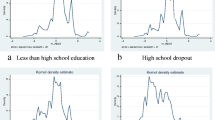Abstract
Understanding employment for African American women through the lens of neoclassical economics may not be best to help understand their plight. Their pay and the available employment has not been equal to that of men and even more so, African American women have lower paying jobs compared to their white counterparts, despite their achievement of higher levels of education. This paper looks at unemployment rates across the nation and then centers the discussion on black women in the context of the disparities over the past three decades. It combines the types of employment and wages that they have endured in context to white women during the same period of time. It uses Geographical Information Systems to underscore the concentration of income and race and the types of employment in those areas. It then provides some policy recommendations for the future.



Similar content being viewed by others
Notes
Baltimore is known by the names of its distinctive neighborhoods and not its census tracts, therefore data is presented by those neighborhoods.
References
Alliance for Excellent Education. Education and the economy: boosting the nation’s economy by improving high school graduation rates. 2011.
Darity WA, Mason PL. Evidence on discrimination in employment: codes of color, codes of gender. J Econ Perspect. 1998;12(2):63–90.
Darity Jr WA, Myers Jr SL, Chung C. Racial earnings disparities and family structure. South Econ J. 1998;65(1):20–41.
Equal Pay Commission. Report of the Equal Pay Commission, Department of Labor. State of Maryland; 2006
Mason PL, Austin A. The low wages of black immigrants: wage penalties for U.S.—born and foreign-born black workers, 298. Washington DC: Economic Policy Institute; 2011.
McLendon L, Jones D, Rosin M. The Return on Investment (ROI) from Adult Education and Training, McGraw-Hill Research Foundation; 2011.
National Bureau of Economic Research. US Business Cycle Expansions and Contractions, NBER’s Business Cycle Dating Committee. NBER; 2010.
Newsome YD, Nii-AmooDoDoo F. Reversal of fortune: explaining the decline in black women’s earnings. Gend Soc. 2002;16(4):442–64.
Pettit B, Ewert S. Employment gains and wage declines: the erosion of black women’s relative wages since 1980. Demography. 2009;46(3):469–92.
US Congress Joint Economic Commission. Women and the Economy 2010: 25 Years of Progress But Challenges Remain, U.S. Congress; 2010.
US Department of Commerce. “Employment.” Women in America: Indicators of Social and Economic Well-Being, White House Council on Women and Girls. United States Government; 2011.
US Department of Labor. Employment Status of Women and Men in 2008, Women’s Bureau of Labor Statistics; 2008.
US Department of Labor. Highlight of Women’s Earnings in 2000, Bureau of Labor Statistics. 962. United States Government; 2001.
US Department of Labor. Women at Work, U.S. Bureau of Labor Statistics. United States Government; 2011.
Author information
Authors and Affiliations
Corresponding author
About this article
Cite this article
Loubert, L. The Plight of African American Women: Employed and Unemployed. Rev Black Polit Econ 39, 373–380 (2012). https://doi.org/10.1007/s12114-012-9140-8
Published:
Issue Date:
DOI: https://doi.org/10.1007/s12114-012-9140-8




